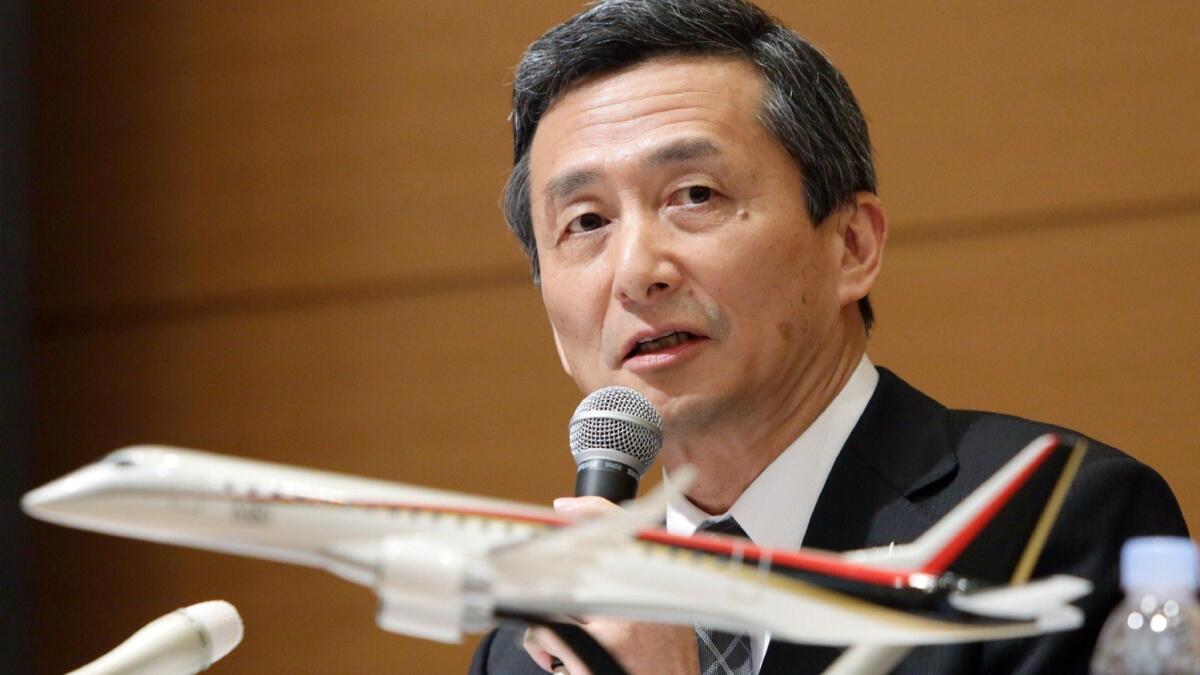Boeing and Airbus face competition from first Japanese airliner in 50 years

A new, long-delayed 88-passenger jet from Japan may finally be the right plane at the right time.
More cities in Asia and Europe are seeking to link up with one another and the global air travel network. The Mitsubishi Regional Jet, the first airliner built in Japan since the 1960s, began certification flights last month in Moses Lake, Wash., to satisfy that demand.
Mitsubishi Heavy Industries Ltd.’s new airliner is testing the skies just as rivals are moving to sell off their manufacturing operations for jets with as many as 160 seats. Boeing Co. is set to buy 80% of Embraer’s commercial operations in a joint venture, while Bombardier Inc. last year sold control of its C Series airliner project to Airbus and is exploring “ strategic options” for its regional-jet operations.
At stake, particularly in the market for jets with fewer seats, is $135 billion in sales over the next 20 years or so, according to industry group Japan Aircraft Development Corp.
“Bombardier’s moves do indeed create opportunities for the MRJ,’’ said Richard Aboulafia, an aerospace analyst at Teal Group. “It’s the biggest single factor in the MRJ’s favor.’’
With few seats and smaller fuselages, regional jets are a different class of aircraft from larger narrow-body planes such as Boeing’s 737 or Airbus’s A320. The MRJ has a range of about 2,000 miles, while a smaller variant can haul as many as 76 people for about the same distance.
A longtime supplier of aircraft components to Boeing, Mitsubishi Heavy is developing the MRJ to emerge from its customer’s shadow. After spending at least $2 billion over more than a decade, the manufacturer is looking to get its jet certified and start deliveries to launch partner ANA Holdings Inc.
Mitsubishi initially planned test flights in 2012 but blew past that deadline because of production difficulties. Now the company — which makes ships, nuclear power plants and aerospace components — expects to have the plane ready for customers next year, a timetable that will test the company, said Mitsubishi Aircraft Corp. President Hisakazu Mizutani.
“This coming year is extremely important for us,” Mizutani said at a media event Tuesday in the central Japanese city of Nagoya.
A lot now hinges on Mitsubishi’s ability to get the jets ready on schedule, said Sho Fukuhara, an analyst at Jefferies Japan Ltd. who said the company’s current 407 MRJ orders aren’t enough to make the program profitable.
“Longer term, there should be an opportunity, but right now they have to deliver the very first plane,” Fukuhara said. “Potential buyers are looking at how they proceed with their schedule.”
The company announced in October it was adding an extra $1.52 billion in capital to its aircraft unit’s existing capital of nearly $900 million; Mitsubishi also canceled about $450 million of debt owed by the aircraft division.
Also adding to Mitsubishi Heavy’s challenges is a lawsuit filed by Bombardier in Seattle in October, accusing the Japanese company of acquiring secret information and causing Bombardier “to suffer irreparable financial loss.” Mitsubishi countersued, denying the Montreal company’s accusations and saying that it violated antitrust laws through “a multifaceted scheme to expand its power within the regional jet market by impeding the entrance of a new competing aircraft.”
Bombardier denies the allegations and will vigorously defend itself, spokesman Simon Letendre said in an emailed statement.
“Our views are completely different, and so we’re looking to get a clear determination in a public forum,” Mizutani said.
Mitsubishi Heavy isn’t the only Asian manufacturer betting that it can build aircraft cheaper and more efficiently. Commercial Aircraft Corp. of China Ltd., also known as Comac, has a new regional jet in service, while Korea Aerospace Industries Ltd. is studying whether to develop a 100-passenger aircraft.
“The aviation market in Asia is expected to grow further in the coming years, and there will be demand for these aircraft,” said Lee Dong-heon, an analyst at Daishin Securities Co. in Seoul. “The shift in the regional aviation segment we have seen over the last year or so has opened opportunities.”
In order to compete, Mitsubishi can’t just rely on its home market. The biggest customers therefore could be in the U.S., where large airlines try to cut costs by outsourcing short flights to smaller carriers that fly regional jets. Trans States Airlines Inc., which operates flights for United Airlines under the name United Express, ordered 50 of the planes, with options for 50 more, in 2010. Trans World didn’t respond to requests for comment.
The weight and capacity of the MRJ now in testing are too large for many regional carriers, according to Bloomberg Intelligence analyst George Ferguson, although the company plans to introduce the smaller version in 2021.
As part of its preparations to ramp up deliveries and support operations, Mitsubishi’s aircraft unit separated its sales and marketing divisions this month, created a customer support unit and moved its U.S. headquarters to Renton, Wash., the Seattle suburb where Boeing assembles its 737 jets.
“The need for regional jets isn’t going down,” Mizutani said “The MRJ is fully capable of competing in the market.”
More to Read
Inside the business of entertainment
The Wide Shot brings you news, analysis and insights on everything from streaming wars to production — and what it all means for the future.
You may occasionally receive promotional content from the Los Angeles Times.










